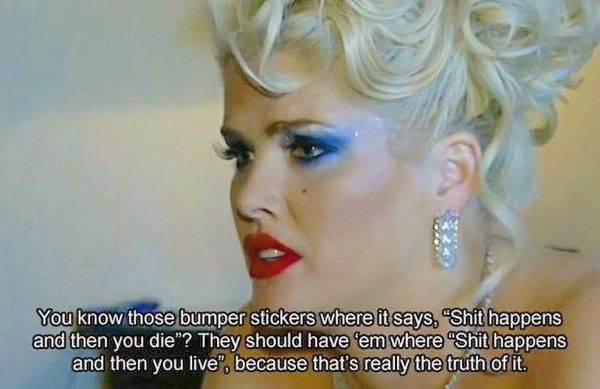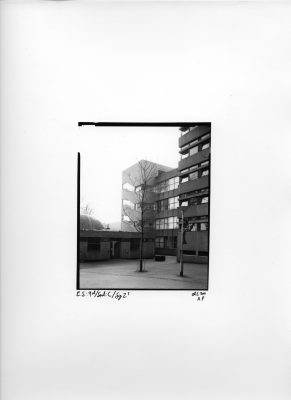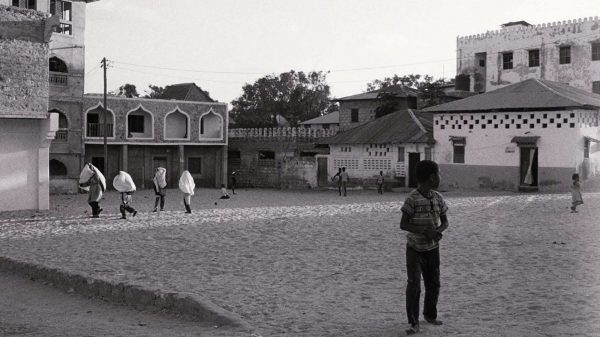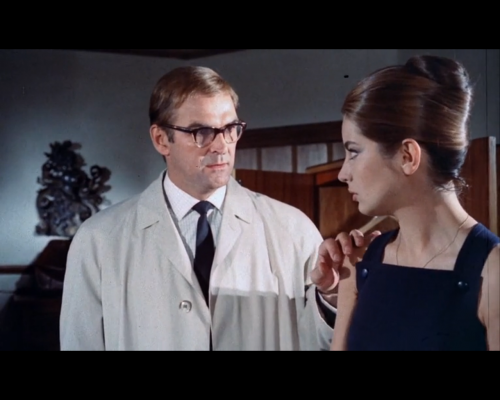Here was a woman who had modelled her life so closely on Marilyn Monroe’s that doing so eventually helped drive her to her death – the blonde waves and the fake breasts; the pill addictions and the airheaded pronouncements about men and sex and diamonds; the years spent tumbling down the rabbit-hole in search of somebody with cash willing to play at being Daddy; the Playboy cover and centrefold, and the unwise sexual exhibitionism, and the occasional moments of bleak honesty that nodded at some formative abuse – and yet still she achieved twice the thing that Monroe never did: for four days, from 7 September 2006 to 10 September 2006, Anna Nicole Smith was a mother to two children. As it had for Monroe, who confessed in her last year that she had wanted children ‘more than anything’, motherhood held as much significance for Smith as big-time fame did, her desire to be the world’s hottest chick only commensurate with her certainty that she should procreate. ‘I’m either going to be a very good, very famous movie star and model,’ Smith told Entertainment Weekly at the height of her success, in 1994, ‘or I’m going to have a bunch of kids. I would miss having a career, but I’ve done my acting, and I’ve done my modelling. I’ve done everything I wanted to do.’ She did not become a great actor, even if for a short time she was one of the biggest models on earth. She did not make it to 40, even though she outlived Monroe by 3 sad, medicated years, dying at the Hard Rock Hotel in Florida at just 39 years old, in 2007.
One thing she did make was herself. Vickie Lynn Hogan, born 28 November 1967, was a flat-chested brunette. At five, she announced her intention to become a supermodel; shortly after, she revised her statement and suggested that, in fact, the thing she really wanted to be was the reincarnation of Marilyn Monroe. (Not an impersonator, note, or an entirely different starlet who took Monroe as her inspiration: the same woman, occupying the same body, not to mention the same obviously troubled mental space.) A deadening, potentially damaging childhood and adolescence followed, culminating in her growing up too fast. On summer nights, she walked or drove the town’s main drag, drinking cheap beer and hollering at boys. ‘I thought, well, if I was to have a baby, I would never be lonely,’ she said of her impoverished, tedious life in Mexia, Texas, married to a teenager she barely knew who had worn blue jeans to their wedding. She gave birth in 1986, turned 18, and then ran away to Houston, leaving in her wake a husband she described as ‘really physically abusive’, a job as a waitress at a chicken joint, and a tumbledown childhood home whose windows – proving that life can be heavier-handed, even, than bad fiction – overlooked a rubbish heap. In her yearbook photograph from 1985, she looks more like an actress from an Ingmar Bergman movie than a bombshell. She has dolent eyes, an air of hunger; a gaze not quite focused on the here and now.
Later in life, she often claimed that she might be Monroe’s long-lost daughter, despite Monroe having died in 1962, five years before her birth. In literal terms, it was quite obviously a lie; symbolically, it could not have been more astute. Monroe’s baby-voiced appeal and her unreal, Coke bottle curves were hardly the most significant bond between the two sex symbols. Like Monroe, Smith was the daughter of an absent Daddy, the product of an unhappy home, and the alleged victim of sexual, emotional and physical abuse. ‘You want to hear all the things [my mother] did to me?’ Smith once asked in an interview. ‘All the things she let my [stepfather] do to me, or let my brother do to me or my sister? All the beatings and the whippings and rape? That’s my mother.’
‘From the moment Anna Nicole got famous,’ one reporter wrote in Texas Monthly, ‘she told the world that her role model was Marilyn Monroe. It was a shrewd move, as it linked her image with one of the greatest American icons of all time, and it had a neat logic: one platinum-haired sex symbol taking after another, one poor, deprived child latching onto the success of another.’ In the 1990s, she ended up renting 12305 Fifth Helena Drive, where Monroe died. ‘I’d love to play a psychotic woman, like Marilyn Monroe in Don’t Bother to Knock,’ Smith told The Morning Call in 1994. ‘She was so good in it, and I just know I could play it. I can just see [it in] her eyes. I know I could get into it.’ She carried VHS tapes of Monroe movies with her at all times in her purse, as if to do so might attract some of her glamour. If Hugh Hefner had not already bought the burial plot next to Monroe’s grave, Smith often said she would have purchased it herself.
Given that Monroe had not been especially fond of him in life, claiming that she had been stiffed financially when he republished nude photographs of her without her consent in Playboy’s inaugural issue in the 1950s, Hefner’s sinister decision to encroach on her in death had seemed at best like an egregious show of ownership over the woman he had used to help define the slick, all-American vision of his magazine, and at worst like a violation. Had Smith occupied the space instead, the implication might be different: certainly, Smith was bisexual, and certainly there may have been a part of her that longed to sleep with Monroe, but the impression left by her desire to sleep with her for an eternity is one of a young woman well aware that she is on the same trajectory as her idol. In 1993, Smith briefly signed on for an unrealised, unnecessary remake of the Monroe-starring noir Niagara, whose screenplay ‘[played] up the sexual undercurrents that, because of the times, were [subtler] in the original’, according to Variety. In the 1953 film, released in the same year Hefner published Monroe’s naked photographs in Playboy, a young couple on their honeymoon at the titular landmark meet another married pair named Rose and George, who are both volatile and wild. Rose is having an affair, and because she is played by Marilyn Monroe, the movie paints her as the physical embodiment of Eros, as untamable and dangerous as the Falls. A promotion for Niagara boasted that the movie had the ‘longest walk’ in cinematic history, with 116 feet of film devoted to one shot of Monroe’s undulating body in a tight skirt and high heels; it failed to mention that the shot, in which Rose does look very hot but also scared, is of her trying to flee her murderous husband, eventually ending with her being strangled in a bell tower.
Smith, herself a remake that played up sexual undercurrents that had been far subtler in the original version, would no doubt have been required to turn the 1953 Niagara’s subtext into text as far as fucking was concerned. Given the iconic nature of the shot, however, it seems likely that the slow walk Monroe’s Rose made to her violent death would have been recreated wholesale, giving Smith the opportunity to follow in her heroine’s footsteps towards certain doom. ‘I can just relate to [Monroe],’ Smith said, in an interview that addressed her speculative casting in the project – adding, as if she had not really taken corporeal form until her transformation into America’s newest, blondest sweetheart, ‘especially after I got my body.’ Because it was 1993, what she meant when she said ‘my body’ was the body that had made her the new Guess? girl, i.e. one of Amazonian improbability. She would have many bodies over the ensuing decade: very fat and very thin, a desired body and a joke body, a drug addict’s body and a junk food addict’s body and the body of a girl who owed it all to the diet drug she once advertised by purring ‘Trimspa, baby!’ By 2006, holding her new daughter Danielynn in a hospital in Nassau, she looks like the very last, most tragic incarnation of Anna Nicole Smith: deeply tanned, extremely blonde, and ultra-vacant. Motherhood might be equated with womanhood, and particularly with the kind of high-femme curvaceousness that gives the impression of an aptitude for sex, but the two quite obviously do not always end up going hand in hand. Monroe miscarried at least twice, her longing for a child only increasing as she moved into her thirties. She may have been a sex symbol – ‘If I’m going to be a symbol of something, I’d rather have it be sex than some other things they’ve got symbols of,’ she once said, ruefully – but she did not see herself as a particularly sexual person, so that for her sex itself remained symbolic, rarely pleasurable and never procreative. ‘I used to think if I ever had a child, I would have wanted only a son,’ she wrote, in a letter to the poet Norman Rosten. ‘But… I know I would have loved a little girl as much – maybe the former feeling was only Freudian, anyway.’
A long-time advocate of psychoanalysis, Monroe recognised her fatherlessness as a thing that left a man-shaped hole in her development, making the idea of a boy irresistible in its promise of a freaky kind of closure. Anna Nicole Smith had a son, and then a daughter, her attitude to the former feeling vaguely Freudian, too: having lustily said her favourite thing was ‘cowboys’ in her Playboy questionnaire, she would often describe him as her ‘favourite’ or ‘number-one’ cowboy, as if his having being made within her perfect body made him automatically her perfect man. ‘Daniel is truly the love of my life,’ she said once, beaming. ‘I am so thrilled to be able to give him the things I never had.’ There are no images of her with other men as easy and as full of unfaked happiness as images of her with Daniel as a boy, her body language often telegraphing some psychic return to adolescence in spite of the Adult-with-a-capital-A shape of her anatomy. ‘People ask me about my childhood,’ she monologues wearily in the opening of an episode of her reality TV show, The Anna Nicole Smith Show (2002–04). ‘Well, I didn’t have a childhood, so I’m having one now.’ Like Monroe, she operated on a continuum between child and mother, one moment expressing her desire to have further babies, and the next naïve and scared. Both women seemed to want a child because of the unspoken implication that to do so meant being loved and loving limitlessly. Whether or not it occurred to Smith that this was one way in which she had managed to outdo her goddess-idol, it would not be possible to say. What it is possible to say is that for three days in 2006 – in spite of everything else that had happened that year, and the year before that, and the year before that – she got everything she had really wanted – more than the fame or the money or the implants or the mansion – two times over. Her faraway look in that hospital photograph with Danielynn is for once not the distant glaze of dopedness, or of put-on dumbness, but a look of being emptied out by tenderness. She is beatific, a Madonna with a dye job.
On 10 September 2006, 72 hours after she had given birth to Danielynn, she would awake in hospital to find her son Daniel dead in a chair, killed by an overdose of Lexapro and Zoloft and his mother’s methadone. Reports suggest that he was sitting at her bedside, that the overdose had been an accident, and that he had been trying to get over a badly broken heart. ‘I want another baby,’ Smith had written in her diary before Danielynn had been conceived, ‘before my Daniel leaves me.’ When she’d written it, she had been referring to him growing up and moving out; now, the line resonated chillingly, as if she’d somehow always known that something terrible would happen, or as if she had unwittingly 49 administered a curse. In the moment of her grief, she lost her mind enough to ask that someone photograph her with the body, so that there remains a mirror for the image of them with her newborn daughter – a pietà in lieu of a blonde Madonna. She claims to have suffered memory loss from trauma, resulting in a total blackout; the hospital later said that they sedated her, then forcibly removed her from the room. It took four hours for them to pry her from his body. ‘It was necessary,’ her attorney Michael Scott informed the press, ‘for Howard [K. Stern, her lawyer and lover] to tell Anna again that Daniel had passed away.’ ‘Daniel was on TV and they were showing all the footage,’ her friend Patrick Simpson said, ‘and she was saying, “see, he’s here, Daniel’s here, he’s coming home”.’
It became necessary to tell Smith a lot of things over and over. Robbed of Daniel, she became a child herself. ‘Anna Nicole Smith spent the last days of her life drifting in and out of consciousness under the pale blue comforter of a king-sized hotel bed,’ the LA Times reported in 2009, two years after her death, ‘too weak to walk, sit up or drink from anything other than a baby bottle.’ Like her idol Monroe, she had been taking chloral hydrate, a sedative that did not mix well with her usual meds; she had developed abscesses on both her buttocks from injecting slimming drugs, and she had been obtaining medication from at least three unscrupulous doctors under numerous false names. Her psychiatrist, Dr Khristine Eroshevich, was photographed sharing a bath with her, which did not bespeak a great interest in upholding the Hippocratic Oath, nor a particularly fervent wish to aid in her recovery from what may have been sex addiction. Smith’s room at the Hard Rock Hotel and Casino in Hollywood, Florida, with its white four-poster bed and marble tub, ended up strewn with her detritus: Slimfast cans, nicotine patches, pill bottles and junk-food wrappers. She remained in it, decaying, as if lying in a tomb. ‘If Daniel has to be buried,’ she had said at her son’s funeral, trying to climb into his coffin, ‘I want to be buried with him.’ (‘I don’t understand why God took him,’ she repeated to anybody who would listen, ‘and not me.’) ‘She was having nightmares,’ one of her legal team later recalled, detailing her terrible insomnia. ‘She was having hallucinations.’
On 5 February 2007, Smith had flown to Florida to buy a yacht, complaining on the flight that she was suffering from pain in her left buttock from injections, and announcing on her limousine ride to the Hard Rock Hotel that she had chills, a cold sensation running up and down her body. When she arrived at the hotel, she had a temperature of 105 degrees Fahrenheit; choosing to treat herself with drugs rather than call an ambulance, she dosed herself to sleep, and woke up drenched in stinking sweat. She did not stir until the morning of the 7th, getting up to eat an egg-white spinach omelette, and then climbing into the hotel-room’s empty tub, disorientated and afraid. At dinner time, she ordered room service, and at around 10 p.m., she watched TV and took more chloral hydrate. By the following afternoon she was found dead, blue-lipped and lying in her own shit. Like Monroe, she was also found stark naked, a reminderof the significance of her body, and of the way maintaining it – to say nothing of inhabiting it – had ruined her.
Because both women are equally as famous for their early, tragic deaths as for their lives, the public has the dubious honour of being able to compare images of them not only on the red carpet or on photographic shoots, but in the morgue. What is eeriest is the fact that side-by-side, Smith’s post-mortem photograph appears to be a recreation of Monroe’s – the dirty, swept-back platinum hair in profile, the colourless lips and thin black brows. When in 2008 the artist Marlene Dumas showed a new painting of Monroe’s morgue photograph in the exhibition ‘America’ at MoMA New York, entitled Dead Marilyn, she cited not only her mother’s death in 2007 as inspiration, but a longing to express what she perceived as the ‘end of a certain era’ in the States. ‘In a sense, it is a portrait of death,’ she told MoMA. ‘But it is also a portrait of Marilyn Monroe. It is a portrait of a period. It is a portrait of one’s own potential death.’ (‘I believe a little bit in voodoo also, you know?’ she added, as if her intention with the painting had been to produce an object whose effect was closer to an invocation or an exorcism than that of a work of art.) Monroe’s death has long been talked about by conspiracy theorists as a possible murder, usually pinning it on the involvement of the FBI after her long-rumoured affair with John F. Kennedy. More likely, if more mundane, was that she took 40 barbiturates on purpose in order to escape an existence that felt murderous.
Anna Nicole Smith’s autopsy suggested she had died as a result of ingesting a mix of medications – chloral hydrate, diphenhydramine, clonazepam, diazepam, nordiazepam, temazepam, oxazepam, lorazepam, atropine, acetaminophen, topiramate and ciprofloxacin – in amounts that were not large enough to kill her in and of themselves, suggesting that the overdose had been an accident, and that like Daniel she’d been trying to recover from a badly broken heart. There was a certain parity with Monroe here, too, even if Smith had not meant to commit suicide: a longing to escape, or to withdraw from, a world in which the desire and attention of the public had begun to feel like violence. ‘Covering a cluster of small scars on her right leg and ankle was an icon medley [tattoo],’ the Broward County medical examiner observes in his summary of identifying features: ‘Christ’s head, Our Lady of Guadalupe, the Holy Bible, the naked torso of a woman, the smiling face of Marilyn Monroe, a heart, shooting flames, and a cross.’ ‘Vickie Lynn Marshall was a 39-year-old white female who died of acute combined drug intoxication,’ the autopsy concluded. ‘Abscesses of buttocks and viral enteritis were contributory causes of death.’ Minus her liveliness, her sex appeal, she had returned to being Vickie Lynn, a fact that might be an indignity if it did not mean that ‘Anna Nicole Smith’ managed in some way to escape death.




